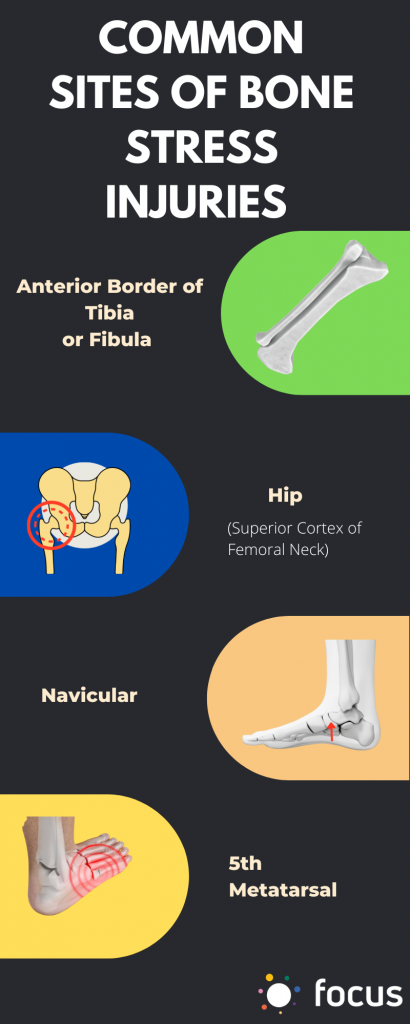How Do Bone Stress Injuries Happen?
A Bone Stress Injury (BSI) can range from a bone stress reaction (painful bone without a crack) to a more advanced stress fracture (painful bone with a crack in it).
When insufficient time is given for the bone to adapt to the external mechanical forces, an imbalance can occur between bone remodelling and microdamage to the bone, resulting in bone structural deformation and fatigue. This accumulative microdamage may continue to progress from the bone being in a state of stress reaction through to a stress fracture and potentially a cortical fracture.
How a Bone Stress Injury Develops:

In runners, high risk stress injuries occur at specific sites, such as the front of the shin bone (anterior border of the tibia), fibula, upper aspect of the hip (superior cortex of the femoral neck), navicular and 5th metatarsal, to name a few. Understanding the location of where the BSI’s occur is crucial not only for diagnosis, but also for prevention, since a history of BSI is a strong risk factor for developing a future BSI. For example, if a runner previously had a tarsal BSI they may be more sensitive to running uphill and this type of training might need to be increased more conservatively in order to prevent a recurrence of the injury.
Typically, bone stress reactions heal faster than stress fractures so early diagnosis is key. However, not all bone stress reactions and stress fractures are created equally, and treatment and recovery can vary depending on which bone is involved and where the injury is within the bone.
We can be much smarter about planning our training to reduce risk of bone stress injuries: We can incorporate a weekly strategy by taking off 1-day per week to allow your physiology and bones to absorb the load of the prior 6 days. When programming we should reduce our training loads every 4th week, particularly speed work and hill running. A rule of thumb: reduce volume of these higher risk training loads by 30-40%.
We should increase our volume before intensity. The workload placed on a bone is related to the volume (number of loading cycles) and the intensity (magnitude and/or rate of load). While we want to gradually increase both over time, bone is more sensitive to changes in intensity. Research shows that fracture risk rises at a much faster rate with increases in intensity as compared to increases in volume. When considering changes in training, think volume first, then intensity. Once you have reached your desired volume then you can manipulate the intensity.

What Happens if I Have a Bone Stress Injury?
If a bone stress injury is at a low-risk site, it will mean complete rest from impact for a set number of weeks and if weightbearing is painful you may be provided with a boot or crutches. We want to mitigate the adverse effects of rest, so we advise cross training where possible, such as aqua jogging or using the stationary bike for some off-feet conditioning.
Due to prescribed rest following the injury, the athlete is likely to see a reduction in muscle mass and strength. It Is essential to restore both during this period to reduce the risk of re-injury when running commences. Alongside strengthening muscles around the injured site, there are certain exercises that are more osteogenic than others. Make sure to rehab both legs – not just the injured one!
The first step to returning to running is to be pain-free during day-to-day life. Once a runner is pain-free for 5 consecutive days of usual activities, they can start a specific gradated loading program. Bone tends to respond best to exercises that are dynamic, moderate or high impact that involve muti-directional movement, this is a good place to start prior to running. Unlike soft tissue injuries, running must be pain-free during and after, if it is not, the bone is not ready for this rate of loading and the program must be regressed. Continuing to run with pain will delay healing and may lead to greater injury.
Once you have a bone stress injury, you have a high rate of re-injury, and it is important not to fall into old habits when you return to normal running. Find a suitable coach or clinician who can help guide your return to run process. If you wish to further discuss with a physiotherapist, you can book an appointment here.

